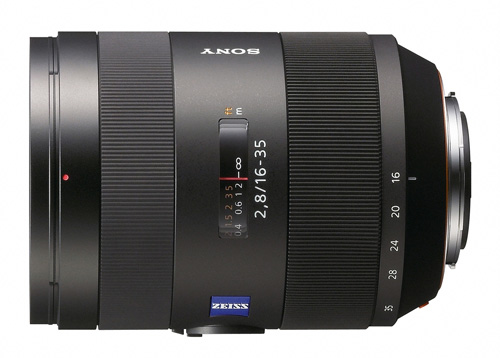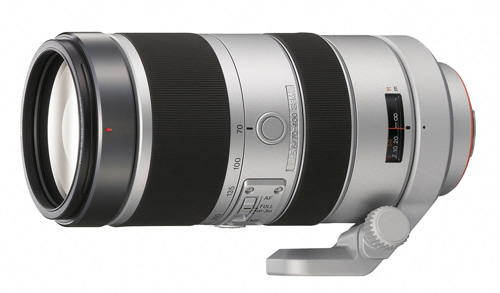Sony A900 Full-Frame: Hands-On Preview
by Wesley Fink on September 12, 2008 12:00 AM EST- Posted in
- Digital Camera
New Zeiss 16-35mm f/2.8 and 70-400mm f/4-5.6 G Lenses
SAN DIEGO, Sept. 9, 2008 - Sony is expanding its number of high performance Carl Zeiss and G Series lenses with the addition of the new SAL1635ZA and SAL70400G models.
Vario Sonnar T* 16-35mm f/2.8 ZA Carl Zeiss Series Lens

The SAL1635ZA model is a super wide-angle 16-35mm f/2.8 constant aperture zoom lens, well suited for landscape, snapshot, and indoor photography. It is constructed of 17 lens elements in 13 groups, including an extra-low dispersion (ED) for exceptional clarity and center-to-edge resolution and a super ED glass element for much stronger correction of chromatic aberration or discoloration. It also features three aspherical lens elements that provide greater brightness from center to the edge of the image field. Its Carl Zeiss T* (T star) coating technology provides higher light transmission, and minimizes flare to produce images of luminous clarity, color and sharpness.
The SAL1635ZA lens offers the utmost flexibility in challenging lighting conditions due to its wide f/2.8 constant aperture. Combined with Sony's in-camera SteadyShot Inside image stabilization system, this lens is the only large aperture, full-frame capable, wide-angle zoom lens with the benefit of stabilization in the industry. Smooth, fast, and precise focusing is delivered by Sony's Super Sonic wave Motor (SSM) autofocus drive system. It utilizes a solid-state focus drive motor to provide silent, high-speed response, powerful torque, and fine rotational control - critically important for large wide-aperture lenses.
70-400mm f/4-5.6 G Series Lens

The SAL70400G lens is a 5.7x super telephoto zoom lens and the latest addition to Sony's G-series line of premium lenses. Designed to deliver extremely sharp descriptive performance across its wide focal length range, it is ideally suited for sports, action, and wildlife photography. Constructed of 18 elements in 12 groups, it includes two extra-low dispersion glass lenses for high contrast, sharp details, and exceptional center-to-edge resolution with minimal chromatic aberration. A circular aperture with nine diaphragm blades is utilized to achieve natural, aesthetically pleasing de-focusing effects.
With a minimum focus distance of 1.5m and maximum magnification of 0.27x, the lens delivers best-in-class performance. Like the SAL1635ZA lens, focus drive is provided by its SSM system, which offers the speed and rotational precision often required for telephoto shooting. Additionally, the lens has an internal focusing system for faster autofocusing.
A focus-mode/range switch and three focus-hold buttons have been added to the lens barrel for enhanced operability. For both models, when attached to the flagship α900 camera body, the AF hold buttons can be customized to activate the intelligent preview function.
Price and Availability
The Vario-Sonnar T* 16-35mm f/2.8 ZA and 70-400mm f/4-5.6 G lens will ship in January 2009 for about $1,800 and $1,500, respectively.










53 Comments
View All Comments
chiew - Saturday, September 13, 2008 - link
what conditions did the a700 survive in that the 1Ds didn't?hanugro - Friday, September 12, 2008 - link
Hm ,I do remember last year that I heard about shooting video and choosing 1 fram as digital still from SOny CEO himself. I don't know whether it is his idea or he heard from someone else. But Sony has stated that it won't put feature that is not ready. I am sure it has cross Sony's mind. Also they are one that among the first develop sensor that can take 120fps but at lower resolution. You have to understand that this 24MP create about 15MB per frame. If your video is 24fps then does the CF available now is big enough? Also don't tell me that SOny should allow lower HDTV 1920x1080 pixel video and hope that you can extract one frame of it and sell it to newspaper. They will laugh at it, newspaper / magazine needs at least 6-12MP pictures before they consider to publish it. Also if you want video then buy videocam instead. I imagine using liveview (or using the sensor for video) will shorten the live of the sensor itself. Whay would I want to do that?aeternitas - Friday, September 12, 2008 - link
I think people willing to pay 3k for a camera;#1 Dont care about 100$ battery. (wtf?)
#2 Could get something better for a bit more if they want new.
#3 Something better for less if they buy used.
#4 Nikon and Cannon will come out with something better for less in a matter of a few months.
"Full frame" is great, but all it does is get rid of crop factoron 35mm cameras. What happeneds when CCDs get bigger? They will need to, becuse no matter what technology the camera has in it, SnR is going to be better at lower MP resolutions on the same size CCD. 24MP sounds fantastic, but noice reduction does not always equate to added detail. The only real way to get more detail, is to actualy replace noise with information and the real only wat to do that is to make the CCD bigger or make the pixelsites bigger.
gipper51 - Friday, September 12, 2008 - link
Nice preview of a very interesting camera. I did notice several times you mentioned the Sony as being twice the resolution as the D3/5D which is not accurate. It has twice the pixels but you need 4x the pixels to truly double a sensors resolving power.This camera should shake up the industry on the high end. I can't see Canikon shooters ditching their current investments and going with Sony because of this cam, but at the very least the era of high resolution FF cameras costing as much as a new compact car is over. Bravo Sony.
chiew - Friday, September 12, 2008 - link
Just a note: Canon's 1Ds mkIII has a larger viewfinder than the A900 in specs...Canon 1Ds mkIII: .76x 100% FF vf
Sony A900: .74x 100% FF vf
Yea the Canon costs more than 2x as much. However, if history has its say, Canon will trickle down the viewfinder like it did from the Canon 1Ds mkII to the 5D (0.70x in the 1Ds mkII and 0.71x in the 5D). Whatever Canon has up its sleeve, its likely a full frame, and hopefully Canon users will get a nice large viewfinder in whatever the followup to the 5D is.
KorruptioN - Friday, September 12, 2008 - link
As for the bump in fps rate with cropped lenses like Nikon does, apparently this is due to a lens design decision by Minolta. The aperture arm must travel a much more significant distance compared to the aperture arms in Nikon's lenses. This physical requirement alone is likely what is limiting all of Sony's DSLRs to 5fps maximum.Wesley Fink - Friday, September 12, 2008 - link
I shot several images with DT lenses and the A900 crop factor worked perfectly. You can also manually force DT, even on a full-frame lens. With that capability, and an 11 megapixel image size in crop mode, a faster shooting speed would have been an incredible feature. The Nikon 5 megapixel crop-mode image is OK for newspaper but too small for some things. An 11 megapixel crop is a lot more interesting.strikeback03 - Friday, September 12, 2008 - link
The point of an L bracket is to get the flash above the lens regardless of camera orientation. This new flash still has the flash offset to the side, so you still need a bracket if you want to move your flash over top of your lens.Wesley Fink - Friday, September 12, 2008 - link
There are some cases where an in-line flash is more desirable, but for most situations where photographers use a flash the Sony 90 degree turn will accomplish just what the photographer is looking for when he attaches an L bracket.haplo602 - Friday, September 12, 2008 - link
I bought a Nikon F75 as my first SLR after some long search and decision making. Then a few days after it's arrival I learned about the Minolta Dynx 7 and regreted my decision. A few months later I had the opportunity to actualy shoot with a Minolta 7D and I was even more unhappy.Now with this new Sony, I am close to tears. The Nikons I have are solid cameras, I do not complain there, however any Nikon camera close to this Alpha sensor will cost a fortune which I cannot afford. The A900 seems like a quality and "cheap" camera.
(I have to add I never owned a DSLR :-))